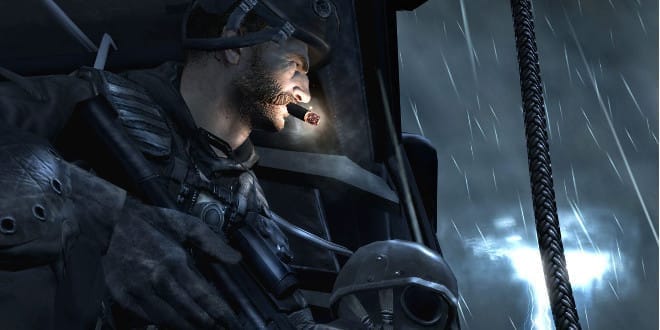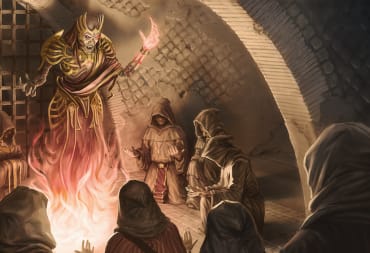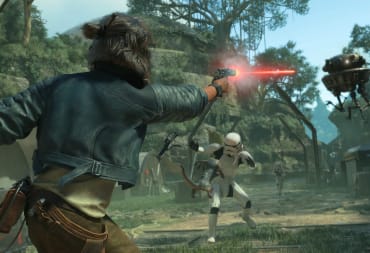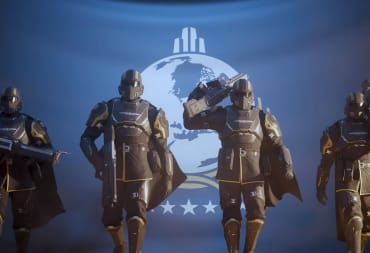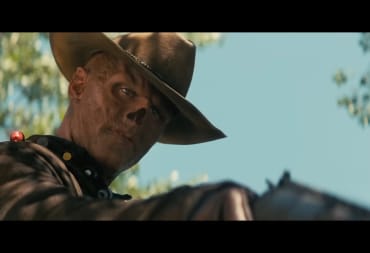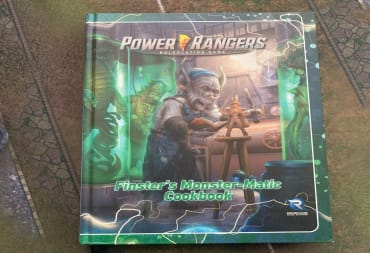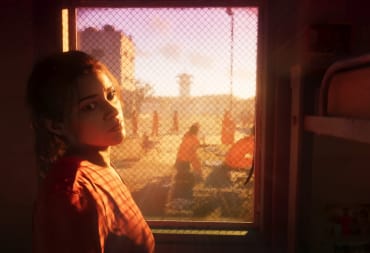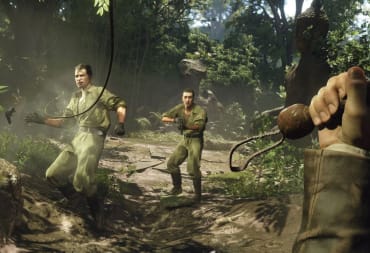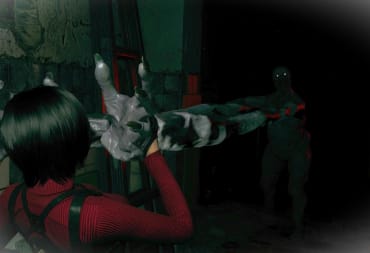For the most part, the cultural presence of gaming properties is an influence of conditioning rather than emotional inflection. Breaking Bad recalls moments like “I am the one who knocks,” a perfect capsule of Walter White’s malignant ambition, while Halo: CE is more remembered for plasma grenade sticking and the Warthog doom run. Nowadays some games aim for both qualities. In pursuit of artistic recognition, titles like The Order: 1886 even raise narrative to preeminence over a thin, almost obligatory base of gameplay. It is self-evident such an approach does not make a good game. Less obvious, but of equal importance, is the failure to understand what makes real art: the marshaling of every element of a work towards a meaningful statement, including, in the game medium, mechanics and objectives.
At the present time, the Call of Duty franchise is renowned neither for outstanding gameplay nor outstanding writing. Some are calling it a sports series with guns, a categorization that seems not too far from the mark given the obvious dependence on multiplayer to sell the yearly releases. Much like traditional sports, Call of Duty even has its own stereotypical fanbase: the fabled “dudebro" and the well-known neckbeard. The convergence of a group known for drunken fraternity rampages and a group that is too slovenly to leave their computer chairs seems a little too far-fetched to be accurate, but that the picture persists is a sign of how widely the series is reviled in the public imagination. Years of DLC cash-milking and apparent Michael Bay homages have taken their toll. Voice chat from the lowest circle of hell—sexually frustrated 13-year olds—was the coup de grâce.
Under this sort of cloud, claiming Call of Duty 4: Modern Warfare as the best game of Generation 7 seems like half-baked satire. To condemn a pioneer for the sins of the present day, however, is such a clear error it bears no explanation. Modern Warfare must be judged on its own merits. It deserves to be judged on its own merits, if for nothing else than the fact that it unequivocally usurped Halo, a feat as shocking as League of Legends overtaking World of Warcraft’s playerbase. Yet while League of Legends competed obliquely with WoW, building a following in a new genre, Modern Warfare went head-to-head in the same genre as Halo only two months after final trilogy installment Halo 3 was released, at the height of the latter franchise’s popularity. Although Halo 3 sold more copies on the Xbox 360, it took only a few months for Modern Warfare—a debut IP all but in name—to eclipse it in the public consciousness. A force of incredible power had made itself known.
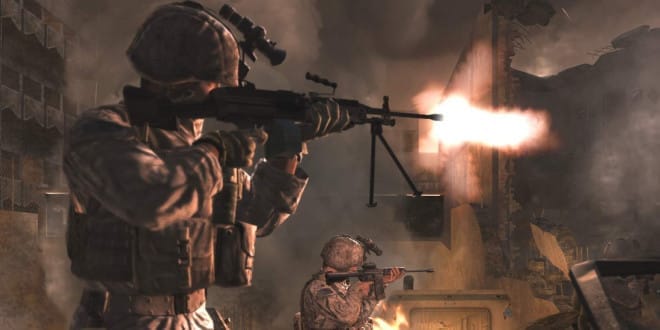
To understand the essence of Call of Duty 4, one has to look beyond the outrageous setpieces, the hit-and-run twitch shooting, and the 80’s action movie characterization that following releases have evolved. None of those elements are present. Neither did developer Infinity Ward merely enhance a campaign model from a past military shooter, or even adopt the cinematic control and silent landscapes that Halo had used to such great effect. Instead, writers went to U.S. Marine Corps base Twentynine Palms to talk to combat veterans of the wars in Iraq and Afghanistan, a resource that had remained largely untapped in the world of video games. As veterans of their Force Recon companies would do just months later for the HBO miniseries Generation Kill, the Marines imparted invaluable knowledge to the development process: motion capture, enemy AI, and the attitude of the 21st century infantryman.
Many have unfavorably compared Call of Duty’s storytelling treatment to efforts perceived as more mature and engaged with narrative. The juxtaposition is hauled out on schedule by a clockwork chorus—fans and critics—for the benefit of prestige titles and indie darlings, The Last of Us and Gone Home. This isn’t another one-dimensional dudebro shooter, we are told: these titles are set on more complex subject matter than hypermasculine, jingoist, and possibly racist adventures in the Middle East. The sentiment is now as tired as the shooters so criticized. Offered in a presumably earnest desire for responsible art, it instead betrays the sort of painful, juvenile insecurity that C.S. Lewis famously scolded. Aim is confused with accomplishment; choices of style are assigned dissimilar values without thought or justification.
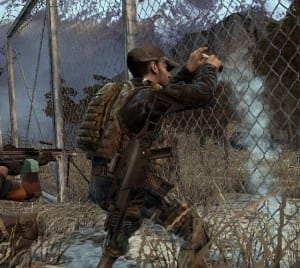 As a consequence, gaming media has largely forgotten Call of Duty 4’s narrative innovation. Building on the success of the diegetic* storytelling of Half-Life 2 and BioShock, the developers decided to eschew cutscenes entirely. Exposition presented over the loading screens is the only concession—otherwise, the campaign’s missions are framed in spare fragments of dialogue experienced from the first-person perspective of one of six characters, from an overthrown president to an SAS commando. These segments are brief in the extreme compared to the gameplay that they facilitate, but brief should not be taken as ineffective. The elements present are precisely curated to maximize impact, honed in on the truest quantum of the experience they are meant to convey.
As a consequence, gaming media has largely forgotten Call of Duty 4’s narrative innovation. Building on the success of the diegetic* storytelling of Half-Life 2 and BioShock, the developers decided to eschew cutscenes entirely. Exposition presented over the loading screens is the only concession—otherwise, the campaign’s missions are framed in spare fragments of dialogue experienced from the first-person perspective of one of six characters, from an overthrown president to an SAS commando. These segments are brief in the extreme compared to the gameplay that they facilitate, but brief should not be taken as ineffective. The elements present are precisely curated to maximize impact, honed in on the truest quantum of the experience they are meant to convey.
In the intro to “Charlie Don’t Surf,” the player, placed in the viewpoint of USMC Sgt. Paul Jackson, is already in motion over a vast concrete city torrenting beneath him, cut with the smoke trails of rocket-propelled grenades; the game has succeeded in replicating the inbound rush of Black Hawk Down in only a few seconds. “Death From Above,” the only mission from the perspective of an AC-130’s infrared gun camera, substitutes the bloodless radio transmissions of the plane’s crew in place of a soundtrack. Though the presentation is understated, it is so genuine that it is immediately arresting.
The gameplay following does not fail the expectations that have been set up. Unlike Halo, which requires mastery of strafing, effective shooting in Call of Duty 4 requires the player to stand still and “shoulder” the virtual weapon, aiming down the iron sights. In isolation, this mechanic would appear to be stagnating, but it actually accomplishes the opposite: the player can also move much faster with a sprint function, which disables shooting, and the opposing extremes create a compelling value judgment. Learning that judgment is essential, since taking fire in the open usually means death. Individual enemies are killed with short bursts, but their numbers and relentless opposition create immense pressure for action. The scene is often chaotic to an observer, particularly one not used to the FPS genre. To a player who has learned the frenetic rhythm, however, there is an unmistakable clarity more and more apparent at the unflagged 60 frames per second that is standard on the proprietary IW 3.0 engine. Proper flanking, sighting, and shooting are instantly rewarded many times over. The result is an FPS faster and more formidable than any before it.
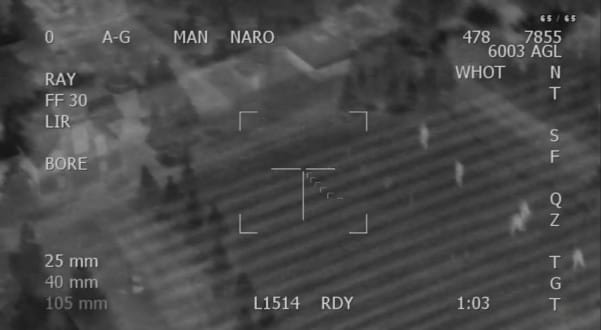
Although the title Modern Warfare is absolute in its simplicity, Call of Duty 4 does not portray combat realistically. (This seems obvious after it has been stated, but the misconception persists.) There is no game worthy of that honor; on engagement with the body of work that combat veterans have produced, it is clear that no game will ever be. But capturing something about an experience has never required a full commitment to realism, as Picasso’s Guernica and scores of other works testify.
Even if it is totally divorced from the pace and the cooperative nature of modern warfare, there are aspects of Call of Duty 4 that are specific, not invented. We know little more about iconic character Captain Price than his role, but when he casts off his cigar and pulls down the gas mask at the beginning of “Crew Expendable,” the unmoved confidence cannot be missed. We hear it in Gaz’s low-key delivery as he explains mission objectives, in the offhand way he comments on gunship support: “An AC-130, eh? Haven’t worked with one of those in a while.” These details were not pulled from the ether, or drawn from the often maudlin drama of war movies. Any coverage of special operations forces (SOF) will show otherwise.
It is no accident, for instance, that the SAS missions are scored with more traditional orchestra, while the Marine Corps missions make use of pounding rock. The dark movement of covert operations is markedly different than overt assaults in both execution and nature, and the cultures of the two organizations are similarly far apart. Even so, is the distinction portrayed truthfully, or is it a bombastic Hollywood construction? Overall, it is much closer to the former; for instance, Navy SEAL Chris Kyle wrote of blasting Drowning Pool and other heavy metal to get pumped up for battle in his memoir American Sniper. Similarly, the lack of soundtrack to “Death From Above” is a deliberate omission, as military aircrew are known for their methodical calm. SOF veterans of the Battle of Mogadishu recalled that their Blackhawk helicopter pilots were professional even on hits by rocket-propelled grenades, spinning to almost certain death.
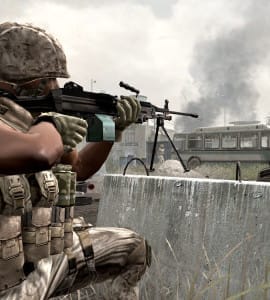 The small kernels of these principles even extend into the design of the gameplay. Call of Duty 4’s campaign is infamous for infinitely respawning enemies in certain settings, but the intended effect is to force the player to constantly take ground, a critical concept of US infantry doctrine (even, and especially, under ambush). The technique of popping in and out of the sights is explicitly noted in “F.N.G.,” the training primer. Generally, it is also the way real assault rifles are handled in combat. Even apparently fantastic mission objectives are culled from real life—the exhausting defense in “Heat,” which pits a small SAS team against a gigantic attacking force, is reminiscent of more than a few last stands of US Army Special Forces during the Vietnam War.**
The small kernels of these principles even extend into the design of the gameplay. Call of Duty 4’s campaign is infamous for infinitely respawning enemies in certain settings, but the intended effect is to force the player to constantly take ground, a critical concept of US infantry doctrine (even, and especially, under ambush). The technique of popping in and out of the sights is explicitly noted in “F.N.G.,” the training primer. Generally, it is also the way real assault rifles are handled in combat. Even apparently fantastic mission objectives are culled from real life—the exhausting defense in “Heat,” which pits a small SAS team against a gigantic attacking force, is reminiscent of more than a few last stands of US Army Special Forces during the Vietnam War.**
In an era of unprecedented artistic ambition among the ranks of game developers, this integration of vision stands out. No one would accuse a Call of Duty game of sacrificing gameplay for the sake of drama, but somehow it becomes one of the few titles to avoid the opposite pitfall: the incipient message of gameplay overtaking the message of the writing, or the “art” of the game. Amnesia: A Machine for Pigs might have a lot to say about suffering, for instance, but in practice the more lasting impression has something to do with tiptoeing around man-pigs. By contrast, Call of Duty 4’s diegetic approach makes full use of game mechanics in service of its writing. The two are inseparable at any stage of the campaign, since the lack of obvious cinematic seams and the breakneck pace of combat crowd out the sort of reflexive peanut-gallery snark that tends to fester with repetition. Focus is demanded. Every enemy is newly important.
The union of script and gameplay has many fantastic moments through the story, but its unquestioned apex occurs at the end of “Shock and Awe.” All US forces, including perspective character Sgt. Jackson, are ordered to evacuate dictator Al-Asad’s home city under threat of a nuclear device. The device detonates as Jackson is leaving the city on the heels of a barely-accomplished rescue of a Marine pilot; their transport is hit by the blast and crashes, spinning out. The player wakes in Jackson’s red-washed vision. Getting out is possible, prone, and most choose to do so, but time is limited. No matter which direction he crawls, clinging to life, Jackson always dies. The simple definition of a game—a fail state—has been applied in a way never before seen in an AAA title. There is no way to win, and the game forces the player to dwell on the end. The mechanic is the message.
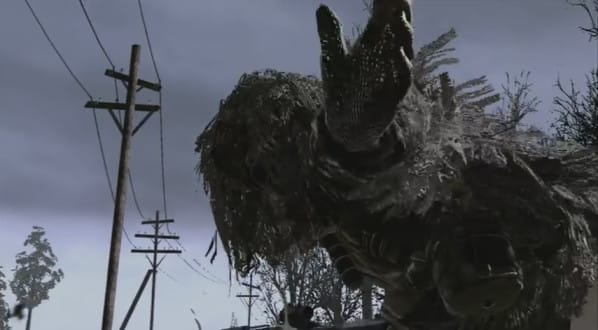
Call of Duty 4, then, does not only work as a great game; there have been plenty of other such titles in the past ten years. Rather it is a game that is also a work, art capable of standing beside film and literature on its own terms. Moreover, its impact at the time was important beyond its medium. Unsure of how to handle the subject of war in the years after the invasion of Iraq, American filmmakers dawdled for years with clumsy political cudgels like In the Valley of Elah before they could even progress to the level of The Hurt Locker, let alone American Sniper. Veterans were imagined as victims, if not crazed killers. Miniseries Generation Kill, although the most valuable take on the Iraq War by far, was limited in reach by the nature of its format.
But Modern Warfare, an extremely engaging game, reached out to tens of millions with an apolitical and truthful portrayal of the professional soldiers engaged in the conflicts of the Western world at a time that the public sorely needed to understand who was fighting for them. As Sgt. "Soap" MacTavish and his few surviving team members are being airlifted at the end of the last mission, "Game Over," a newscast mentions that a search for a missing cargo ship—the same freighter raided in the very first mission—has been called off. The world he has fought for will not thank him, much less understand what he has given in its defense. But his efforts are meaningful all the same.
Call of Duty 4's vision was so successful, in fact, that it has been adopted—or sometimes ripped off—countless times, from the realistic aesthetics of the infantry in Titanfall to the game’s own shameful sequels, all of which abandoned much of the commitment to plausibility of any sort. But its own effect cannot be revised. I know of at least two servicemen, one in SOF, who were influenced to join in part due to the impression Modern Warfare made on them several years ago. Even now they refer to Soap and Captain Price.
Search all you can: that’s a legacy of no other game.
*The term diegetic refers to elements in the world of the story, i.e. audio logs. Non-diegetic elements include soundtracks, subtitles, and camera angles, since they are not part of the fictional reality. Thus, an event experienced from the player perspective is a purer example of diegetic storytelling, as opposed to a cutscene, which makes use of camera angles.
See also: the found footage genre, also known as “diegetic camera.”
**Incredibly, “Heat” is somewhat true to life in another way: the defense is successful in large part because the SAS has set up buried explosives to thin out the attacking forces, just as US Army SF used landmines—a different, but similar concept—to delay pursuing forces in the Vietnam War. Today, however, the use of landmines is banned across US SOF, which has contributed to the deaths of Americans in similar last-ditch defenses such as the one that occurred in Operation Red Wings.
Which studio do you think handled the Call of Duty IP the best? I'd go with Infinity Ward, of course, but things were getting a little weird by Modern Warfare 3.
Have a tip, or want to point out something we missed? Leave a Comment or e-mail us at tips@techraptor.net
